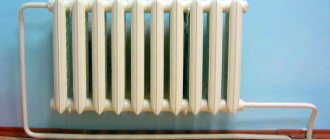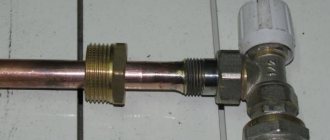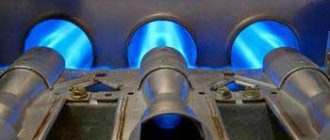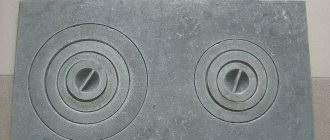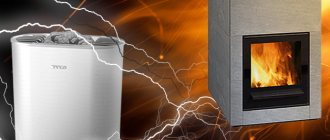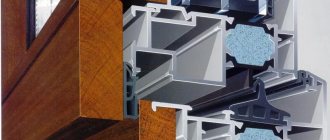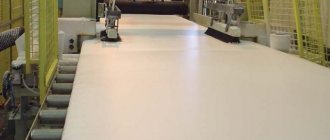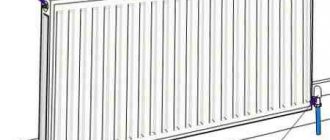Differences between cast iron and aluminum batteries
It is unlikely that the central heating network can be called a favorable environment that is suitable for any type of metal.
On the contrary, the coolant in it is often not only aggressive, since it has high acidity, causing corrosion, but is also heavily littered. For this reason, some types of radiators are not recommended for installation in high-rise buildings with a central heating method. Replacing cast iron batteries with aluminum counterparts in apartment buildings is not the best option for updating the heating system. There is a simple explanation for this, which is best conveyed by comparing the technical indicators of these two metals.
| View | Design | Connection type | Volume | Corrosion resistance | Operating pressure | Building height | Guarantee | Heat dissipation |
| cast iron | sections | lateral | old: 1.5l new: 0.8l | high | 9-12 atm. | 5 floors | 10-30 years | 110 W |
| aluminum | sections | lateral | 0.2-0.27l | low | 15-18 atm. | 5-9 floors | 10 years | 140-180 W |
The table clearly explains why aluminum radiators cannot be used instead of cast iron ones. Their low resistance to the chemical composition of water and short service life make it possible to successfully use their other qualities in autonomous heating systems.
Therefore, the question of how to replace a cast-iron battery with an aluminum model in an apartment building should not even be asked. They are not an alternative to each other. Replacing cast iron with aluminum in a private home is a great opportunity to significantly increase the heat output of a heater for little money, thereby reducing heating costs.
Bimetallic radiators
Despite their novelty, bimetallic radiators have taken one of the leading positions. Thanks to research, it was found that it is much more efficient to use steel pipes to transport the heat conductor. At the same time, it is much more efficient to use aluminum panels for heat transfer.
Thanks to the combination of the best qualities of each material, it was possible to make more efficient bimetallic radiators.
In addition, aluminum panels look more modern. The weight of the final radiator is lower than that of cast iron, which is one of the additional advantages of this design.
The image shows the principle of the structure of bimetallic radiators.
Of course, everything is quite individual. Both aluminum and cast iron batteries are good and bad at the same time. For some, the main thing is cheapness and efficiency, for others aesthetics are much more important. But any battery, even the most ugly one, can be transformed/hidden with the help of decorative panels. Read about how to make a decorative panel that, among other things, will direct heat where it is needed. For private homes, steel radiators can be a reasonable compromise. But still, it's up to you to decide.
- User's blog 5energy
- Login or register to post comments
Flat radiators
For compact placement and freeing up space, flat models are used.
Characteristics:
- Smooth front panel that does not allow dust to accumulate on it.
- Dimensions – from 30 cm to 3 m.
- A small amount of water is consumed, which makes it easy to regulate using thermostats.
- Bottom and side connection.
- Used as a decorative element, strict shapes or bright colors.
The operation is similar to panel and sectional: a coolant circulates between two metal sheets; if a heating element is installed, an electric flat version is obtained.
Working pressure is up to ten atmospheres, maximum water heating is 110 C. There are single-panel, double-panel and three-panel heaters.
The main advantage is its compact size and fast heating. In addition, they are easy to care for and have an attractive and stylish appearance. The decoration of flat heat exchangers allows them to fit into any room design, and the mirror surface will replace the mirror. Small installation depth and good thermal radiation indicator.
The disadvantages include the impossibility of installation in wet areas to avoid corrosion, as well as the high cost.
Removing old batteries
Even if you only need to replace a section of a cast iron radiator, you will have to carry out preparatory work and dismantle the entire device. The sequence of actions is as follows:
- All media is drained from the system, for which its supply through the pipes is shut off.
- Dismantling a cast iron heating radiator begins with installing some kind of support under it and a container for draining remaining water.
- Use a pipe lever wrench to remove locknuts and flanges. If they are “stuck” and soured that it is impossible to unscrew, you will have to use a pipe cutter and cut off a piece of pipe directly in front of the nut.
- After the battery is disconnected from the heating system, it must be carefully removed from the brackets. The stand as a stop will prevent you from dropping the cast iron radiator, which is quite possible given its weight and the media remaining inside.
If a section needs to be replaced, it must be removed by disconnecting it from the nipple. As a rule, simply replacing the damaged section with a new one does not end the matter, since there is no point in installing the battery back without cleaning it from possible scale and rust.
The next stage is installing the radiator in place or connecting a new model, for example, made of bimetal.
Battery replacement technology
Replacing heating radiators, unless it is an emergency, should be carried out exclusively in the summer. This will minimize the chances of someone being flooded and left without heat for a long time. At the same time, there is no need to warn any of the neighbors that work is coming to replace the batteries.
The simplest and supposedly civilized option is to hire a professional team. To replace each radiator, even in a large apartment, technicians, if they are experienced, usually only need a few hours. If they completely change the heating system, they can spend from one to several days on this work.
Replacement of batteries proceeds according to the following scheme:
- The water from the heating system is completely drained.
- Next, each radiator is untwisted (cut off).
- To properly replace batteries, you now need to install level marks (preferably laser) on the wall.
- Install brackets.
- Hang a new radiator.
- Connect to heating pipes.
- Test the updated pressure system.
Such a simple replacement can only be done by the hands of good craftsmen. Although in fairness it is worth noting that for them this process may not be as smooth as we would like. Doing it yourself will be even more difficult, but practically free. The specialists have the following prices:
- The cost of removing a cast iron battery to replace it with a new one is 200 rubles for 10 sections;
- Craftsmen can remove a bimetallic or aluminum radiator for free, if, of course, this service is part of a general work package that includes the installation of a new heating radiator.
- A professional can just hang a 10-section cast iron radiator for 400 rubles;
- A specialist will install a new bimetallic (aluminum) radiator with your own expensive hands, without connecting it, for 200 - 250 rubles.
- Connecting each of the replaced radiators will cost 600 rubles. This, if the replacement involves connecting only to the supply pipe. To connect to the return line, the master will require the entire 1,000 rubles.
In general, in order to change one radiator through a specialist, you should prepare for the fact that you will have to part with your hard-earned money in the amount of 1,000 to 1,500 rubles. For a three-room apartment with a kitchen, the cost of such work will be about 6,000 rubles, and if the rooms are large and have two or three radiators, then twice as much.
An opportunity to save money is to replace heating radiators yourself. Do everything just like the masters and even better, albeit slower.
Replacing batteries yourself
In order to quickly change batteries with your own skillful hands, you need to purchase in advance what you will need during this process. This is, first of all,
- Wrenches, adjustable and wrench.
- Flax fiber.
- Brackets.
- Silicone sealant.
- Mayevsky valves (or ordinary ball valves). They are mainly installed on the upper and first floors.
Naturally, replacing batteries begins with dismantling old heating radiators. Then for radiators you need to check the level of the brackets. If everything is in order with them, then the new heating battery can be installed. Next comes the connection to the pipes.
In a private house that is heated by a boiler, a circulation pump is needed. But even now, in small housing constructions, craftsmen can suggest installing radiators and heating pipes at a slightly inclined angle so that there is natural circulation of water.
In this case, you need to use a sealant; tighten the nuts tightly, but so that they do not burst. After replacing the radiators, you must be at home when starting the heating system. What if a leak does occur, which can be quickly fixed without flooding your neighbors or yourself.
You can easily replace old batteries with new ones yourself. But, if you don’t mind the money, it’s still better to hire craftsmen. Then only the role of a controlling body or a grateful observer will remain.
Bimetallic heating radiators, which ones are better, selection instructions
The first heating radiators made from two metals (bimetallic) appeared in European countries more than sixty years ago. Such radiators coped well with the assigned function of maintaining a comfortable room temperature during the cold season. Currently, the production of bimetallic radiators has been resumed in Russia; the European market, in turn, is dominated by various radiators made of aluminum alloy.
Which bimetallic heating radiators are better?
Bimetallic radiators are a frame made of steel or copper hollow pipes (horizontal and vertical), inside which coolant circulates. Aluminum radiator fins are attached to the pipes outside. They are attached using spot welding or special injection molding. Each section of the radiator is connected to another by steel nipples with heat-resistant (up to two hundred degrees) rubber gaskets.
Bimetallic radiator design
In Russian city apartments with centralized heating, radiators of this type can withstand pressure up to 25 atmospheres (with pressure testing up to 37 atmospheres) and, thanks to their high heat transfer, perform their function much better than their cast-iron predecessors.
Radiator - photo
Externally, it is quite difficult to distinguish bimetallic and aluminum radiators. You can make sure that your choice is correct only by comparing the weight of the specified radiators. Due to the steel core, the bimetallic one will be approximately 60% heavier than its aluminum counterpart and you will make an unmistakable purchase.
The structure of a bimetallic radiator from the inside
Positive aspects of using bimetallic radiators
- Bimetallic panel-type radiators fit perfectly into the design of any interior (residential buildings, offices, etc.) without taking up much space. The front side of the radiator can be one or both; the size and color scheme of the sections are varied (self-painting is allowed). The absence of sharp corners and overly hot panels makes aluminum and steel radiators suitable even for children's rooms. In addition, there are models on the market that are installed vertically without the use of brackets due to additionally present stiffening ribs.
- The service life of radiators made from an alloy of two metals reaches 25 years.
- Bimetal is suitable for all heating systems, including central heating. As is known, low-quality coolant in municipal heating systems negatively affects radiators, reducing their service life, but bimetal radiators are not afraid of increased acidity and low quality coolant due to the high corrosion resistance of steel.
- Bimetallic radiators are the standard of strength and reliability. Even if the pressure in the system reaches 35-37 atmospheres, this will not damage the batteries.
- High heat transfer is one of the main advantages of bimetal radiators.
- Regulating the heating temperature using a thermostat occurs almost at lightning speed due to the small cross-section of the channels in the radiator. The same factor allows you to halve the volume of coolant used.
- Even if there is a need to repair one of the radiator sections, thanks to the well-thought-out design of the nipples, the work will take a minimum of time and effort.
- The number of radiator sections required to heat a room can be easily calculated mathematically. This eliminates unnecessary financial costs when purchasing, installing and operating radiators.
Negative aspects of using bimetallic radiators
- As mentioned above, bimetallic radiators are suitable for use with low-quality coolant, however, the latter significantly reduces the service life of the radiator.
- The main disadvantage of a bimetallic battery is the different expansion coefficient of aluminum alloy and steel. After prolonged use, creaking may occur and a decrease in the strength and durability of the radiator.
- When operating radiators with low-quality coolant, steel tubes can quickly become clogged, corrosion can occur, and the level of heat transfer can decrease.
- A contested disadvantage includes the cost of bimetal radiators. It is higher than that of radiators made of cast iron, steel and aluminum, but considering all the advantages, the price is completely justified.
general information
Cast iron batteries are a heating structure consisting of sections that are made of gray cast iron by casting . Depending on the volume of the room, the number of sections can vary: from 2 to 20-30 or more, and their height from 35 cm to 1.5 meters . The section is hollow inside and has either one or two channels. When installing, batteries are placed on legs or hung on reliable brackets to the wall, as they have a lot of weight - one section weighs from 5 to 7 kg . They have a long service life - 50 years or more . They are used for central heating, where the water may contain aggressive alkaline compounds, solid impurities (sand, pebbles), thus, this high-pressure coolant negatively affects the structure of the battery material, destroying it from the inside.
Bimetallic batteries are a heating structure, the sections of which consist of a core - steel or copper and aluminum armor. The batteries can be assembled from separate sections with the possibility of expanding or replacing each, or cast as one piece. The second option is the most reliable when exposed to high pressure in the central heating system, but is less suitable for repair, since in the event of a malfunction it is not possible to replace a separate section; the entire battery will have to be replaced. Prefabricated structures can be used for heating private houses, without the danger of leaks at the joints due to low water pressure. They are much lighter in weight than cast iron - the weight of one section is about 2 kg, the height of standard sizes is 350 and 500 mm . The service life depends on the core material: from steel - about 20 years , from copper - up to 50 years or more . They are expensive heating systems.
Replacing cast iron radiators with bimetallic (metal) ones is justified for several reasons:
- Modern appearance - bimetallic ones look more aesthetically pleasing and are suitable for various interiors of residential or office premises.
- Reduced weight load - cast iron batteries are much heavier than metal ones; they require good fastening and a high-quality wall that can withstand the massive weight of the structure.
- The need for rapid heating of the room - bimetal heats up quickly and quickly gives off heat to the room, cast iron takes a long time to warm up itself, and only then begins to give off heat.
- High water pressure in the heating system - cast iron radiators can withstand pressure up to 10-12 atmospheres, while bimetallic ones are more stable - about 20 atmospheres or more.
- Possibility of extending the radiator or repairing it - a cast iron structure cannot be repaired in the event of a breakdown, but metal ones can be changed in sections, added or reduced in number.
- Ease of installation of the radiator - installation of a heavy cast-iron structure cannot be done alone, but a lightweight modern version made of bimetal can be installed without outside help.
- Resistance to water hammer - cast iron, due to its fragility, is not able to withstand water hammer; bimetal structures can withstand almost any pressure drop.
Replacing cast iron radiators with bimetallic ones may not always be correct:
- Aggressive coolant - alkaline impurities in water are equally not harmful to cast iron or bimetal in winter, but in summer, when air enters the heating system, the steel core will be susceptible to corrosion.
- Durability of operation - cast iron construction is more durable; it can last for decades compared to metal equipment.
- High heat capacity - when heated for a long time, cast iron gives off heat without cooling down for a long time; this quality is useful in case of a possible shutdown of the heat supply, when the room will remain warm longer.
- Budget cost - one section of the classic cast iron variety costs from 300 rubles, bimetallic ones start in the price range from 500 rubles and up to 700-800 per unit.
- Modern cast iron radiators made by artistic casting are not inferior in appearance to metal ones and harmoniously combine with interesting design ideas for decorating a room.
bimetallic or aluminum
- turn off the heating
- drain the water from the system
- placing something supporting under the old battery, and a water container on the floor at the intended cutting location, we cut off the old radiator;
- remove it from its hinges;
- we cut the metal pipes at the same distance and cut the thread;
- we screw in the tees, from which both the bypass and the battery will go further;
- since I needed to turn on the heating if possible (it’s not summer), I first assembled a bypass. You can fill the system and turn on the heating (picture on the right);
- Next, we install ball valves on the tees, shutting off the supply to the battery itself;
- we screw the “American” ones to the taps;
- hang the battery on the wall;
- we measure the length, cut off the metal-plastic from the “American” ones to the radiator itself: from below - to the near edge of the battery, from above - to the far (the pipe will go above it);
- We screw a plug into the remaining holes of the battery from below, and an air vent from above (I prefer an automatic one. The seller gave me a compact one instead of the usual “barrel”);
- Having connected the bimetallic battery, open its taps and close the bypass tap;
- when the battery is filled with water, press the air vent float with a paper clip to help the air escape;
- ???
- PROFIT
Pipes... How much rubbish has leaked onto your Russian fingers?
The problem of cold batteries worries many owners of apartments and houses if the radiators are old. Due to age, they become clogged with such specific rubbish - black powder, which is so heavy that it is not washed out with water down the system, but settles “wherever it is,” that is, at the bottom of the radiators and along the entire length of the pipes. Although I washed the heating system with caustic soda after installing a new boiler, practice shows that dirt from the radiators does not dissolve in this rather aggressive solution. Therefore, part with your old batteries without regret!
Why did I choose bimetallic batteries rather than aluminum ones?
Arriving at a specialized plumbing store (Aqualink), I laid out my “drawing” (sketch) and began to assemble this entire “constructor”. The person in line advised against taking an aluminum baratea for a private home, saying that the water would “eat it up” over time. Instead, I recommended buying a bimetallic radiator (they are absolutely identical in appearance). It’s, of course, more expensive (10 sections cost me 8,000 versus 4,600 for a “luminka”), but I’ll have peace of mind. I’ve been wondering for a long time: should I buy Chinese? And I want it (because it’s half the price), and I inject it (who knows, maybe it will leak over time?). I took Italian. Together with all the tee corners, the purchase cost me 12,000+ wooden ones. Plus, you also need a machine for cutting threads, because metal-plastic needs to be joined to old heating pipes. I borrowed this thing (Rotenberger) for a day from a plumber I know. Naturally, thanking him for his concern. But I saved on labor costs.
How to unscrew the last piece of pipe without the penultimate one starting to unscrew
If you want to unscrew the last (outermost) piece of an old composite heating pipe (or water supply), but do not want the penultimate one to begin to unscrew, proceed as follows: I took a clamp from a thread cutting machine (Rothenberger, see above), secured it to pipe so that it rests on the floor (or a wall), I tapped it (as an option: heat it with a blowtorch) and easily unscrewed the piece of pipe I needed (or rather, now unnecessary).
How to unscrew the outer pieces of pipes?
Replacing radiators involves one trick.
If you need to unscrew the last piece of pipe, but at the same time you do not want the penultimate one to suddenly begin to unscrew, then follow this rule. Take a clamp from a thread cutting machine and secure it to the pipe so that it rests on a hard surface (floor or wall). Tap on all sides and heat with a blowtorch. After these simple steps, you will be able to unscrew any pipe.
Replacing old radiators is not only expensive, but also troublesome. If the problem was only how to replace old cast-iron batteries with bimetallic ones, it would be easier to solve. But the situation requires calculating the power of the new device in order to know exactly how many sections are required, determining its size to match the existing heating system, and studying its technical parameters.
Replacing cast iron batteries with bimetallic ones means introducing a new design into the existing heating network, so you need to take into account all the nuances of dismantling obsolete elements, installing and connecting new ones.
Removing old batteries
Even if you only need to replace a section of a cast iron radiator, you will have to carry out preparatory work and dismantle the entire device. The sequence of actions is as follows:
- All media is drained from the system, for which its supply through the pipes is shut off.
- Dismantling a cast iron heating radiator begins with installing some kind of support under it and a container for draining remaining water.
- Use a pipe lever wrench to remove locknuts and flanges. If they are “stuck” and soured that it is impossible to unscrew, you will have to use a pipe cutter and cut off a piece of pipe directly in front of the nut.
- After the battery is disconnected from the heating system, it must be carefully removed from the brackets. The stand as a stop will prevent you from dropping the cast iron radiator, which is quite possible given its weight and the media remaining inside.
If a section needs to be replaced, it must be removed by disconnecting it from the nipple. As a rule, simply replacing the damaged section with a new one does not end the matter, since there is no point in installing the battery back without cleaning it from possible scale and rust.
The next stage is installing the radiator in place or connecting a new model, for example, made of bimetal.
What is needed to replace the heating battery
In order to replace the heating battery, you will need a hand tool:
- angle grinder;
- metal discs;
- adjustable wrench 4" - 12";
- pipe wrench;
- drawers for cutting threads on pipes (if the system was routed with metal pipes); winding - tangit;
- hammer drill with a set of drills – 6-12 mm in diameter;
- soldering iron for soldering polypropylene with attachments for pipes with a diameter of 20 and 25 mm.
In addition to hand tools and the battery itself, you will need some materials, without which installation of a bimetallic heating radiator is impossible:
- battery assembly kit - four plugs with plugs;
- Mayevsky valve - to bleed air from the system;
- two or four universal hooks for attaching the heating radiator to the wall; two ball valves;
- several meters of polypropylene pipe with a diameter of 25 mm and 20 mm (depending on the wiring diagram, location of the radiator);
Which batteries should you choose?
There are many models of radiators made from various alloys on the modern market. Each has its own positive characteristics and features of use.
Aluminum batteries
Radiators made from this material are produced in two types – cast and extruded. The former are a one-piece monolithic structure, while the latter are made of aluminum parts welded together. Leaf type batteries are more durable and reliable.
Regardless of the type, aluminum radiators have common basic technical characteristics:
- section weight – from 1 to 1.47 kilograms;
- permissible maximum coolant temperature – 110 degrees;
- product power – from 82 to 212 watts;
- the maximum liquid volume of one section is 0.46 liters;
- working pressure – from 6 to 24 atmospheres.
Batteries have been made from aluminum since the eighties. These days, the products have improved quite a bit and have not lost their popularity.
Aluminum batteries
The main advantages of aluminum heating radiators include:
- light weight of the product, facilitating its quick installation and transportation;
- high level of heat transfer due to rapid heating of the metal and the intensity of heat exchange;
- the ability to adjust the temperature even with a small volume of coolant;
- relatively low price for the product;
- good strength;
- decent appearance.
Along with the advantages, aluminum batteries have some disadvantages:
- low resistance to corrosion;
- the possibility of formation of air in the system due to the chemical process.
If we take extruded models into account, we can highlight their weak point - threaded connecting fasteners. With a sharp increase in pressure in the system, the integrity of the structure may be compromised
Radiators made of steel
The installation of such radiators is justified in private houses with a local autonomous heating system. The peculiarity of devices of this type is:
- working pressure – from 6 to 13 atmospheres;
- The maximum water temperature in the battery is 110 degrees.
Despite their relatively low technical characteristics, steel radiators are very popular. The use of devices has the following advantages:
- compact designs;
- possibility of adjusting the temperature using a thermostat;
- high heat transfer rates;
- a wide variety of models produced;
- the cost is much lower than many new types of batteries being released.
Among the disadvantages, the most significant are:
- incompatibility with an open heating system;
- susceptibility to corrosion;
- special requirements for the quality of the coolant used.
Radiators made of steel
The presence of various chemical impurities in the liquid used in a steel battery can cause destruction of the material. In this case, coolant leakage is sometimes observed due to violations of the tightness of the connections. Therefore, steel radiators are not installed in multi-storey new buildings.
Bimetallic batteries
Radiators of this type are improved models that combine all the advantages of aluminum and steel products. The devices have earned widespread use due to their high technical characteristics:
- maximum internal working pressure – 60 atmospheres;
- heat transfer – up to 190 watts;
- maximum coolant temperature 110 degrees.
There are many advantages of using bimetallic radiators:
- long service life - up to fifty years;
- high thermal output and quick heating of the room;
- good anti-corrosion properties;
- high level of strength;
- possibility of installing additional sections;
- maximum sensitivity to thermostat commands;
- Availability of models with different design solutions.
Bimetallic batteries
The material can withstand high hydraulic shocks typical of central heating systems.
The disadvantage of bimetallic radiators is their high price. As a rule, they are more expensive than aluminum or steel products. Cheap bimetallic batteries do not have corrosion protection, so over time, rust will form on the product.
Sectional and non-separable radiators
It was noted above that bimetallic heating radiators can consist of several sections or be of a non-separable type.
In the first case, each horizontal section inside has a pipe, threaded on both sides. With its help, connecting nipples with rubber gaskets are screwed in for sealing. It is the connection points that are the weakest point in sectional batteries and are most prone to damage. In addition, high temperature and high pressure in the system also cause leaks in these places. As a result, the time between preventative maintenance is reduced. However, sectional radiators still have a positive aspect. If one of the sections is damaged, only the failed element is replaced or removed. This should be taken into account when determining which bimetal radiators are better.
Monolithic production of bimetallic radiators allows you to avoid many troubles. The technological process involves manufacturing a solid manifold from stainless steel or copper, placing it in a special mold, which is subsequently filled with aluminum under pressure. The output is monolithic bimetallic batteries.
The disadvantage of monolithic radiators is the lack of maintainability. A leak in such a battery requires its complete replacement.
Comparing the characteristics of two types of radiators and determining which bimetal heating radiators are better, the following can be noted:
- The service life of sectional radiators is 30 years; monolithic products can be used for half a century.
- The operating pressure of sectional batteries does not exceed 25 bar, monolithic - can reach 100 bar.
- As for cost, monolithic radiators cost almost 20% more than sectional batteries.
- Sectional domestic heating radiators allow you to regulate the amount of heat in the room by installing or removing a certain number of sections. In the case of monolithic batteries, this possibility is not available, so before purchasing them, it is necessary to accurately determine the required power.
In addition, when choosing sectional or monolithic batteries, the features of the heating system are taken into account. For example, systems of multi-storey buildings are characterized by high pressure and the presence of water hammer, as a result of which the connecting nodes of sectional radiators may be damaged
To decide which bimetal radiator to choose that does not allow leakage, you should purchase monolithic devices.
Differences between cast iron and bimetallic radiators
As a rule, consumers, when deciding to replace old-style cast iron batteries, study devices made of other metals existing on the market. Currently, analogues made of steel, aluminum and bimetal are on sale, while new generation cast iron batteries are completely ignored, but in vain.
If we consider an alternative to the old “accordions” installed in apartment buildings with central heating, then the most reliable replacement will be batteries made of cast iron and bimetal. There is an explanation for this:
| View | Design | Connection type | Volume | Corrosion resistance | Operating pressure | Building height | Guarantee | Heat dissipation |
| cast iron | sections | lateral | old: 1.5l new: 0.8l | high | 9-12 atm. | 5-6 floors | 10-30 years | 110 W |
| bimetal | sections | side and bottom | 0.25l – 0.4l | high | 25-50atm. | 9 and above | 25 years | 170-200 W |
As can be seen from the table, new-style cast iron radiators, like bimetallic models, may well become a replacement for old devices. The most significant difference between them is the price. Batteries made of cast iron, as before, are much cheaper than their counterparts made of other metals, while bimetal is considered the most expensive in the modern thermal equipment market.
If you need to replace cast iron batteries at minimal cost, then you need to purchase devices made of the same metal and with the same technical parameters. As a rule, such a procedure will not take much time and will not cause much trouble.
Replacing cast-iron heating batteries in an apartment located in a five-story building with bimetallic counterparts is an inappropriate waste of money. Modern cast iron models look no less stylish than aluminum or bimetal ones, and the metal itself has been tested for strength in Soviet heating systems.
How to paint
If it is not possible to replace old cast iron batteries with more modern heating devices, many people repaint the radiators in the desired color. The entire painting process can be divided into several stages:
- Selection of paint;
- Surface cleaning;
- Paint application;
- Drying the product.
To treat such surfaces, it is recommended to use alkyd dyes, heat-resistant varnish with the addition of bronze or aluminum powder. In addition, for such work you can use water-based paint, to which you can add various pigments to obtain the desired color.
At the initial stage of work, working tools are prepared and the surface of heating devices is cleaned. This can be done using a wire brush, coarse sandpaper or an angle grinder equipped with a special attachment. To facilitate the work, special solutions are used that help destroy the old coating.
The washing liquid is applied to the surface using a brush. After leaving for a certain time indicated on the solvent packaging, the old layer of paint will begin to wrinkle and peel off. The coating can be removed with a small metal spatula. The final cleaning of the battery is carried out using a metal brush.
At the next stage of work, the radiator is thoroughly cleaned with sandpaper and primed, which will help the paint adhere better. The best type of primer is considered to be the GF021 brand; it is suitable for any type of dye.
Next, a layer of paint is applied using a paint brush. The composition is applied carefully from top to bottom. For better coloring, the dye is applied in several layers. In this case, you need to take a break between the stages of applying the coloring composition.
Installation of new radiators
If the question of whether it is worth replacing cast iron batteries with modern bimetallic devices is decided in favor of the latter, then installing them will not be difficult, even alone. The weight of these structures is quite small, so you can not only carry out the work yourself, but even use the remaining fasteners from cast iron batteries, if they are not loose.
For the installation to be successful, you need to study the product data sheet, which indicates how it should be connected to the heating system. Bimetallic sectional radiators have 4 holes, through two of them the coolant will flow in and out, and the remaining two must be closed with plugs that are included with the heater.
The sequence of actions when installing batteries is as follows:
- Depending on the size of the bimetallic heating radiator, a place under the window is determined for it; it is better if the location is in the center of the opening.
- The radiator is placed exclusively in a horizontal position, and there must be a factory protective film on it, which should not be removed until the end of the work. This will protect the product from possible external damage, such as paint chips.
The installation of a two-metal battery must be carried out taking into account the distance from the wall, floor and window sill, approved by SNiP. If these parameters are violated, the performance of even such a powerful device may be reduced.
- If it is necessary to install new brackets, then the battery must be attached to the selected location and marked with a pencil on the wall where the brackets should be.
- The brackets are fixed to the wall with dowels and cement mortar if it is brick or reinforced concrete. Drywall will require the use of double-sided fasteners.
- The bimetallic radiator is hung on brackets and connected to the heating pipes according to the selected scheme.
- The tightness and correct connection to the system are checked.
Having the necessary tools at hand, installing a bimetallic radiator in place of a cast iron one will not be difficult
Procedure for replacing the heating battery
- https://vse-pro-otoplenie.ru/radiatory-otopleniya/9-bimetallicheskie-radiatory-otopleniya-kakie-luchshe.html
- https://vse-pro-otoplenie.ru/radiatory-otopleniya/37-tehnicheskie-harakteristiki-bimetallicheskikh-radiatorov-otoplenija.html
To replace the battery we need:
bimetallic radiator;
a set of nuts and plugs for the radiator;
connecting elements in two copies: tee, coupling, tap with Euro nut (American);
- a piece of corrugated galvanized pipe 60-70 cm long;
- a pair of brackets for hanging the radiator.
Since heating system pipes most often have a diameter of 3/4 inch, we buy a set of nuts and plugs for the radiator exactly for this size. We take taps, couplings and tees with a size of 3/4 inches. The tee connector going to the jumper should be 1/2 inch in size (the coolant flow through the radiator must be greater than through the jumper), and accordingly the galvanized pipe should be 1/2 inch in size.
If you are using a different type of heating pipe, you may need different fittings.
Step 1. Draining the coolant and dismantling the cast iron battery
We begin work by shutting off the heating riser and draining the water. To dismantle the old radiator, you need to unscrew the nuts connecting the radiator to the pipes, and remove it from the hanging hooks.
Unscrew the nuts carefully, without damaging the threads on the pipes.
We install a bimetallic radiator by installing a jumper between the “supply” and “return” pipes. This will make it possible in the future to remove the battery without draining the water, and regulate the temperature by blocking the flow of coolant passing through the radiator.
Step 2. Prepare elements for connecting the new radiator to the pipes
We assemble the fittings together, connect the euro nut with the radiator nut, and use flax or fum tape at the joints.
We assemble the second set of elements in the same way (it is necessary to take into account that in the first case the tee will look down, in the second - up) and twist everything together with the pipes.
Step 3. Prepare and install the battery
According to its design features, the bimetallic radiator has four holes (two input and two output) for various connection schemes. We screw the plugs from the kit into those radiator holes that we don’t need (the nuts and plugs in the kit have O-rings, so the use of fum tape is not necessary here).
Be careful, one of the plugs is equipped with a Mayevsky valve for bleeding air; it should be installed in the upper part of the radiator.
We screw American nuts into the coolant inlet and outlet holes.
First, we hang the battery on the pipes, connecting the Euronuts with the taps, setting the battery level, and using a pencil we put marks on the wall for drilling holes for the hooks.
We remove the battery. Using a hammer drill, we drill holes, drive dowels into them, and screw in hooks. We install the radiator again by hanging it and screwing it to suitable pipelines. We check the level and fit of the radiator to the hooks, if necessary, adjust the hooks, ensuring a tight fit of the radiator to all brackets. After this, we finally pack all the threaded connections.
Step 4. Install the jumper
We accurately measure the distance between the tees of the upper and lower pipes and cut off a piece of galvanized pipe of the required length. Lightly roll the ends of the pipe using a file so that there are no sharp ends that can cut off the silicone gasket in the fitting.
We clean the ends of the pipe from plastic to a length corresponding to the entry of the galvanized pipe into the tee (1.5 - 2 cm).
Loosen the tee fittings (without unscrewing them completely) and insert the ends of the pipe into them.
Since the pipe is flexible, we straighten it by bending it. We finally tighten the fittings.
We fill the system with water, open both radiator taps. After filling, release the air accumulated in the radiator using a valve. The heating battery in the apartment has been replaced.
Professional assistance in battery repair
At home, only certain types of damage to aluminum radiators can be repaired independently - small holes, dirt. However, if there are significant equipment defects or if you have doubts about your abilities, it is better to turn to specialists for help.
Repairing heating radiators is, in general, a simple matter and does not require much special knowledge. The main thing here is to have a general idea of what this radiator is. Therefore, we should first understand what kind of radiators there are, and only then talk about their repair.
Repairing heating batteries is a delicate thing
So, a radiator is a heating device that consists of columnar elements, or sections. All these sections are hollow inside and coolant circulates through these cavities. In most cases this is water, but there is also another heat-carrying liquid. For example, mineral oil.
Materials for the production of modern radiators
Instead of cast iron radiators, you can install the following models:
- Made of aluminum.
- Of steel.
- Made of copper.
- Bimetallic.
The radiator, which is made of aluminum, usually has a small weight, but at the same time a stylish design, good thermal conductivity and heat dissipation. The disadvantage is that it is necessary to constantly maintain the pH of the water in the system, as well as sensitivity to pressure changes. They are absolutely incompatible with copper pipes. Radiators made from steel also have good heat transfer and low weight, and they also have a fairly reasonable cost. But they cannot be left without fluid in the system and they are susceptible to corrosion, which is a significant drawback. Over time, the coating may peel off, and they also do not withstand water hammer.
But bimetallic radiators are the most popular. They have increased heat transfer, are resistant to pressure changes and can last for many years. They are not subject to corrosion, have an attractive appearance, and are also quick and easy to install. But such pipes are expensive and at first you will hear some crackling in the system due to the steel and aluminum.
It should be remembered that before changing, it is best to consult with a specialist so that the choice is ideal.
Is it possible to replace radiators yourself?
If the apartment owners do not have an engineering education with a specialization in heating systems, it is better to entrust the replacement of radiators to professionals. The slightest mistake can lead to the batteries not heating well or starting to leak.
For example, I know stories where, due to lack of knowledge, batteries were connected to the hot water supply system. It seems logical: in order for appliances to heat, hot water must flow into them. But no, radiators can only be connected to the pipes of the heating system, otherwise they will quickly become unusable.
The fact is that the heating system always uses the same water, which is used in a closed cycle. And if there are any harmful impurities in it, their effect on the battery metal is limited. In a hot water supply system, water flows through an open cycle and is constantly renewed, so new impurities will constantly appear, which will harm the radiators over and over again.
Some apartment owners entrust the installation of batteries to teams that do other repair work: laying floors, plastering walls, gluing wallpaper. But they often do not have an engineering education, and they know no more about heating systems than the apartment owner.
The best option is to contact specialists, at least a full-time plumber of the management company. At least if problems arise, there will be someone to file a claim with. The main thing is to get documents from the plumber or management company about the replacement, because replacement without documents is no better than the work of an incomprehensible master from the Internet.
You can also use the services of specialized organizations
When choosing a contractor, it is important to pay attention to several points
The company must have a license to install heating systems. It is useful to read reviews about a potential contractor and understand how long they have been in business. It is necessary to conclude an agreement that will indicate the terms of work, their list, cost and guarantees. Finally, it is important that, following the replacement, the technician performs a pressure test of the system (this is also done in the summer). This way it will be possible to detect possible leaks that specialists must eliminate
And only after this is it worth signing a certificate of completion, which will be useful if problems arise with the radiators in the future.
Reasons for the necessary replacement
The following reasons should push owners to replace the heating radiator:
- A small number of radiators are located in the required area. Because of this, the room is not heated properly.
- No thermostat.
- Poor space heating.
- The heating system model has long been outdated and has become unusable.
- The presence of corrosion on the radiator, various damage in the form of cracks and system leaks.
All these factors lead to the fact that the temperature in the space is constantly low, and there is simply no way to regulate the indicators yourself. There is also a high probability that sooner or later the neighbors below will be flooded. As a result, considerable amounts of honestly earned money are paid for heating, but there is no heat at all. Of course, it is recommended to replace the heating radiator in the spring or summer, when the entire house is turned off. But if it is not possible to wait, then this procedure can be performed during the heating season. But then the whole house will have to be turned off from heating for a while. To prevent your neighbors from being doused with boiling water, you should ask qualified specialists for help.
(no votes yet)
New cast iron batteries
If the advantages of a cast iron battery outweigh its disadvantages for you, we can recommend you high-quality modern cast iron batteries. In the Santekhbomba store you will find several practical options - the STI Nova 500 and STI Nova 300 models are presented to your attention. They differ from each other in size and power characteristics - for example, the “older” model 500 has a heat transfer of 150 W per section, section weight at the same time it is 4.2 kg, volume – 0.52 l. For the 300 model, these figures are respectively 120 W, 2.9 kg and 0.3 l, while it is 20 cm lower. Both radiators have an original design; a heat-resistant polymer coating is applied to the surface.
For those who prefer a familiar design, the classic MC-140 model is perfect. Consisting of 7 sections of 150 W each, it looks almost the same as “those” Soviet batteries. And, of course, it is still heavy, since it is made of real cast iron. However, you haven’t forgotten what advantages this material has, have you?
What is the price
The cost of cast iron radiators will depend on the overall dimensions of the product, manufacturer and brand. The oldest model of domestic production is considered to be MC 140. A separate section of such a battery costs an average of 340 rubles per piece, the price depends on the markup of resellers and the region.
Also, cast iron batteries from foreign manufacturers (Italy, Czech Republic, Spain, Turkey) are supplied to the domestic market. Such devices differ from domestic ones in various respects. For example, the capacity of the section of the Czech Termo battery is almost two times smaller - 800 milliliters, while the domestic MS 140 holds 1.4 liters of water.
Radiator Nostalgia (retro) in the interior
The price of one section of foreign cast iron radiators in rubles is as follows:
- Brand Kiran 92/500 – from 335 rubles;
- Manufacturer Viadrus termo 500/95 – no less than 450 rubles;
- Company Nostalgia (retro) 500/180 – from 2120 rubles;
- Demrad 350 brand – no less than 400 rubles per section.
Central heating system and its features
Most of the requirements that should be considered when choosing a radiator are related to the type of heating system. For example, in apartments, a centralized system is most often found, which has both its pros and cons. That is why you need to choose a heating unit, taking into account all the features:
In the central node system, heat is generated thanks to the main line that moves the coolant in a closed circle
The load can reach 16 atmospheres, which means that you need to carefully consider the technical characteristics of the battery. The coolant operates at different pressures, which creates water hammer, which affects the operational life of the battery. The water temperature is also unstable; changes can negatively affect the condition of the radiator and pipes. Very often, accidents of one kind or another occur in the heating system, so it is very important that the radiator can withstand various operating conditions. The connecting materials must be compatible with the unit in order to avoid its failure. Due to the high demands placed on the quality of batteries by the centralized heating network, it is necessary to carefully consider the options offered on the market
Due to the high demands placed on the quality of batteries by the centralized heating network, it is necessary to carefully consider the options offered on the market.
Conclusions and recommendations
- For an individual heating system in a private house, with low pressure, you can install cast iron or sectional radiators; under such conditions they will work perfectly.
- In an apartment in a high-rise building with central heating, where there is high pressure, poor-quality coolant, and water hammer is likely, it is better to use metal radiators.
- For an individual heating system with automatic temperature control, cast iron structures are not suitable due to their inertness; only bimetallic ones can be used here.
- In old “Khrushchev” buildings with low water pressure in the heating system, cast iron structures can continue to cope with the task; there is no need to replace it with bimetal.
- If there are no budget restrictions and all other operating conditions are met, then you can be guided only by aesthetic considerations and install expensive bimetallic batteries with a copper core or cast iron batteries, “retro” style, the price for one section of which reaches 2000 rubles.
Modern designs of heating systems allow an individual approach to solving the issue of home improvement, selecting equipment that meets the requirements of operating conditions, and taking into account the aesthetic and taste preferences of consumers.
